Cedar Fever Relief: Treatment and Cure
Cedar Fever is a problem for many Hill Country residents, especially in the Austin-San Antonio area where I live. After at least 20 years of personal experience and considerable research, I want to share how I got rid of the ashei juniper allergy to developed into pneumonia two years running! It was personal with me!
I am not the only one, according to this popular Texas Monthly article.
Managing the effects of the pollen helps a person feel better and your body accepts the pollen without "over-reacting." This page will help you figure out if it's cedar fever or a number of other problems, including a sinus infection, bronchitis, and or pneumonia. If you can't tell, please consult a physician sooner rather than later.
I am not the only one, according to this popular Texas Monthly article.
Managing the effects of the pollen helps a person feel better and your body accepts the pollen without "over-reacting." This page will help you figure out if it's cedar fever or a number of other problems, including a sinus infection, bronchitis, and or pneumonia. If you can't tell, please consult a physician sooner rather than later.
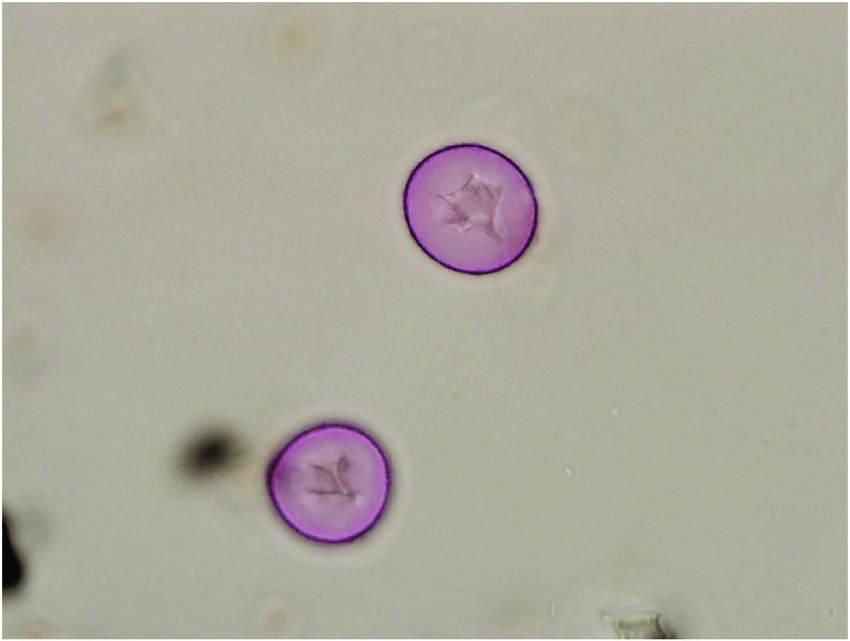
This is a closeup of the pollen itself under an electron microscope, courtesy of the University of Tulsa, Oklahoma.
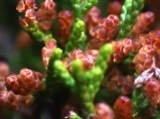
These are the pollen pods that give them their characteristic "burnt orange" color. It's what gives U of Texas it's trade-mark color!
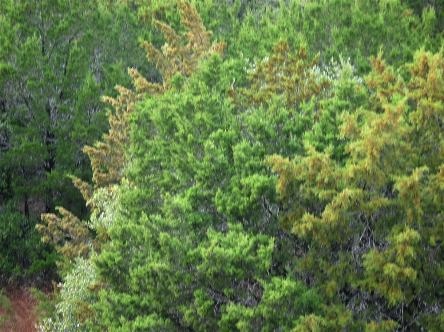
Ashei Juniper grove. Notice how whole trees are covered with pollen at peak of season.
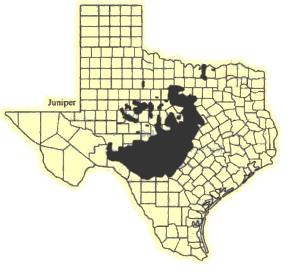
This is a map of where the largest populations of "mountain cedar" are found in Texas. Other places include southern Oklahoma on into parts of Arkansas and west into New Mexico. It is a smaller drought-tolerant evergreen tree with a unique smell. It is valued by some for its ability to hold the soil from infrequent floods and provided food (berries) to wildlife. In some areas, it is home to endangers species (golden-cheeked warbler). It is hated by others because it spreads so profusely and its pollen is so irritating to most people in the Christmas to Valentine's Day time period.
Cedar Fever can irritate just about everybody who comes into contact with it since there can literally be 50-times as what is considered 'high.' For example, 500 ppf is considered high; on January 6, 2020, the mountain cedar pollens were measured at 28,160! It seems to coincide with the cold, dry, northerly winds blowing it over large areas. When the wind stops, things are better. Many people are accustomed to closing up their windows and doors during this late December to mid-February the minute they realize the wind direction has changed and is now coming from the north! Then they stay inside until the winds subside…
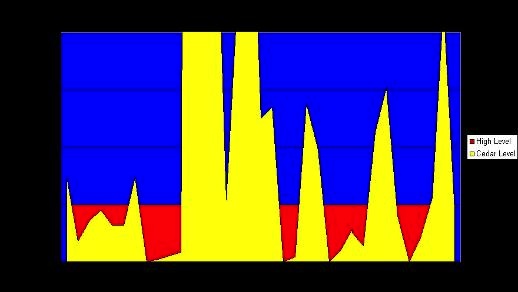
The pollen-level spikes can get really high, as the chart I build a couple of years ago, below, graphing them to see how often and how high the spike were. If you pay attention, you will note coincidences with strong northern winds. The time period is December to Valentines Day. The red level is when there is enough pollen to be considered "high." The yellow spikes are actual pollen levels measured by some medical doctors in the parts-per-square foot level.
Is it Mountain Cedar Fever?
There are many respiratory problems in the winter and it is sometimes hard to distinguish what is going on. In this time of the COVID-19 pandemic, it might be a good idea to rule that our first if you are having some of these symptoms. Testing is available and inexpensive, if not free.
The cedar fever is often confused with the common cold (also a virus). Treating an allergy is different than treating an infection. You can find an update of the chart here on WebMD.
In any case, make sure you find out whether or not you have an allergy or not. If you have a sinus infection, it can morph into a head cold with sore throat, coughing, bronchitis, and even pneumonia. (This is what was happening to me and how this page came about. I went to an allergy specialist (yes, it was the only allergy I had), had a deviated septum treated, and then I went to work to get rid of my allergy. I did not want to get pneumonia again or rely on shots. I love my hill country home and did not want to move!
The cedar fever is often confused with the common cold (also a virus). Treating an allergy is different than treating an infection. You can find an update of the chart here on WebMD.
In any case, make sure you find out whether or not you have an allergy or not. If you have a sinus infection, it can morph into a head cold with sore throat, coughing, bronchitis, and even pneumonia. (This is what was happening to me and how this page came about. I went to an allergy specialist (yes, it was the only allergy I had), had a deviated septum treated, and then I went to work to get rid of my allergy. I did not want to get pneumonia again or rely on shots. I love my hill country home and did not want to move!
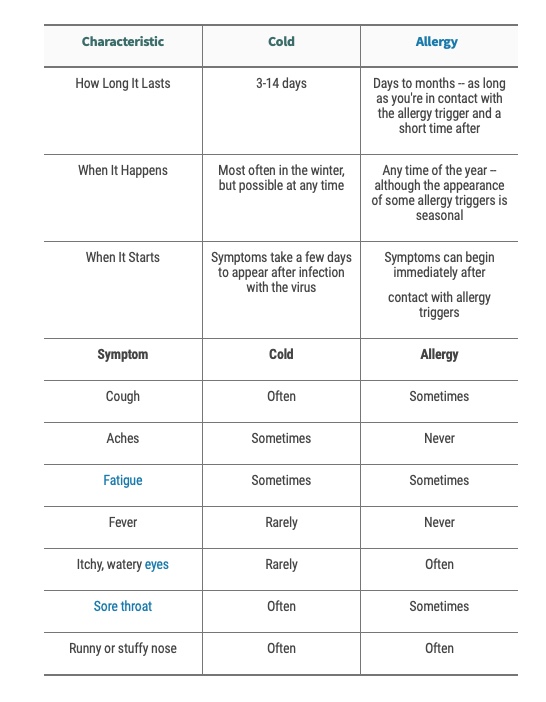
Read Here if you have Mountain Cedar Allergy.
Aggravating Factors:
1. Winter usually brings cold, dry north winds that blow in tons of pollen. Humidities are sometimes as low as 15%. The pollen levels spike at these times, sometimes 50-times what is considered heavy.
2. In the winter, we turn on the heat, drying our home and our sinuses, especially at night.
3. The dry air outside and the now even drier air inside really dry out our sinuses. There is nothing to prevent the cedar pollen from irritating the now dry, irritated (and swelling?) sinus passages. They need to be moist to function normally, to get rid of the pollen naturally. When really dry and really irritated, our immune system causes a large amount of mucus (or snot) to flow and clean, remoistening our sinuses.
4. During the holidays, it is easy to get very dehydrated, especially with holiday alcohol, caffeine, many medications and not drinking enough water in the first place. This dehydration has an especially noticeable on the sinus cavity. Our whole forehead area can really start aching.
5. Over-the-counter products often defeat the body's efforts to clean and rehydrate our sinuses. Prescription medications often dehydrate the body to stop the mucus flow. Add in stress common around the holidays and the new year, you have a wonderful recipe for a miserable time.
6. Snoring, often a problem in normal times, can really complicate mountain cedar fever.
WHAT NOT TO DO
1. Avoid over-the-counter medications that are self-prescribed that further dehydrate you. Decongestants made for colds may actually make it worse. Your body is actually coping and getting rid of the pollen with the snot flows. Stopping it defeats the purpose and prolongs the irritation and the agony. Be attentive and aware of what is going on.
2. Don't ignore it if things get worse. You can get very dehydrated and trigger a cascade of respiratory problems. If an infection gets started, you may need medical intervention, especially when it is hard to tell the difference on what is actually going on. Do not wait until things go south, as they sometimes do.
What to Do at the First Signs of Cedar Fever
1. Invest in a good humidifier especially for your sleeping area. It will add the moisture to the air that you are missing. It is not uncommon for humidities to drop to around 10%. That isn't very good if you are used to the 40-60% level.
2. Take a good OTC antihistamine like Claritin. Some of the newer ones, like Claritin, do not dehydrate your sinuses. I like the generic form of loratadine (Claritin), which can be found at low prices at Sam's or Costco. It can also be found much more expensive, so you might need to look around, maybe even Amazon.com. See the label for specifics. It minimizes the watery eyes, itchy palate and excess mucus flow through the nose, according to online sites. My pharmacist wife like NasalCrom, another OTC, which can be used as a preventative if used before you are exposed, according to www.rxlist.com.
3. As soon as you get a headache from the cedar or oak pollens, take your favorite anti-inflammatory medication, such as aspirin, Advil, Excedrin or Tylenol. It slows the pain without unduly dehydrating you and hopefully prevents the inflammation known as an infection.
4. Stay indoors during the windy days when the wind is f rom the north or northwest. This cuts down on breathing the really high pollen levels and the driest air. Hopefully you have the humidifier so that inside is now more humid than it is outside.
5. Limit your caffeine, alcohol and sugar intake, which is hard around the holidays and the Super Bowl. Drinking a lot of water to stay hydrated really helps and can counteract the times when you do partake at parties. This is especially true if the prescription medications you are taking also dehydrate, like I do. Diuretics for high blood pressure are a common factor. Ask your pharmacist if you are not sure.
6. I spray saline solution up my nose when I get headaches, malaise or especially upper sinus pains. It safely washes out any pollens, including where it goes over the hump from the nose into your throat. You can experiment with brands, but my favorites are Ayr and Ocean Breeze brands. I find that the most effective ones are also the most expensive. The HEB or pharmacy house brands are 'okay' too. If it seems too weird to spray stuff up your nose, it was to me too, at first. I got really desperate and finally tried it. I learned that it did not hurt at all, especially if the saline solution was lukewarm. Now I do it regularly during pollen season, as needed.
You may have noticed a lot of commercials for Netti-pots, which allows you to put home-made salt water, put the spout into one nostril and pour. It will come out the other nostril. If you wish, there is a motorized version, called "Naväge" that gently pushes the saline water through your system, cleaning out your nostrils of any problem matter and pollen. It can also be used at other times of the year as well. I have never needed the Naväge, but they are quite popular and work well for this purpose.
As always, for any of these nasal cleaning products, please check the labels and you will be on your way to feeling better and dealing with the irritating pollen.
7. We snore. This is characterized by natural restrictions of the nasal passages, especially at night, when fleshy parts of the sinus relax and or move. When these tissues get irritated, they often expand, closing off the nasal passage, drying the sinus even more. The result is breathing is impacted or prevented, causing mouth breathing. The lack of breathing causes many to start taking OTC meds that have dehydration as one of their side effects. The dehydration, irritated dried-out nasal tissues and inflammation/infections are exacerbated big time. For me, it would start this way with dry air, stuffy then inflamed nasal tissues and pollen getting caught in my nose and sinuses. From the irritation of the pollen on the dried-out sinus caused an infection that very quickly when down my throat, causing a sore throat, then bronchitis and several times, pneumonia. That is when I got serious and determined to do something about it. This web page is the result.
Not only do breathing problems make cedar fever worse, they are an issue year round. I really do not like C-Paps and other surgical techniques and that gave me the courage to try the saline nasal sprays. I also noticed many big guys who play football also use Breathe Right nasal strips to keep their noses a bit clearer. They are easy to put on: I wash any oils off my nose and pop it right on. They work great and me and my wife use them every night, year round. It helps with the snoring as well. I can at least get to sleep before any symphony begins. It has affected many relationships, when folks begin to sleep in separate rooms. They are relatively inexpensive compared to drugs, and there are some generic ones, but the original work better and you can get 72 in a box. They are worth it! They keep me sleeping and are a part of avoiding cedar fever.
8. During the days of high pollen counts, the pollen gets in my eyes and makes them water. Overnight, I often get those little pollen "crunches." I wipe them out each morning (not a good idea unless my hand is clean). This is precisely what Vision-A is for. It often makes my eyes less itchy and I can see better what I am doing. Some of the pharmacies have generic versions, which I will assumer work just fine.
My every-night regimen during pollen season is keeping our bedroom humidifier serviced, wearing the nose strips nightly, taking ibuprofen for any headache, cleaning my nasal passages if there is pain or stuffiness, drinking up to 96 oz. of fluids each day, concentrating on water, not including caffeine or alcohol. I take the loratadine as needed and stay inside if there is a sudden temperature drop with high winds from the north, bringing in loads of pollen that blows the peg off the meter! If I must go outside, I highly recommend those COVID masks, as they will catch the pollen. Hopefully you have some left over from the pandemic - this is a good time to use them! They also are effective if you have outside work to do in the winter time, thus keeping dust and pollen from bothering your nose!
1. Invest in a good humidifier especially for your sleeping area. It will add the moisture to the air that you are missing. It is not uncommon for humidities to drop to around 10%. That isn't very good if you are used to the 40-60% level.
2. Take a good OTC antihistamine like Claritin. Some of the newer ones, like Claritin, do not dehydrate your sinuses. I like the generic form of loratadine (Claritin), which can be found at low prices at Sam's or Costco. It can also be found much more expensive, so you might need to look around, maybe even Amazon.com. See the label for specifics. It minimizes the watery eyes, itchy palate and excess mucus flow through the nose, according to online sites. My pharmacist wife like NasalCrom, another OTC, which can be used as a preventative if used before you are exposed, according to www.rxlist.com.
3. As soon as you get a headache from the cedar or oak pollens, take your favorite anti-inflammatory medication, such as aspirin, Advil, Excedrin or Tylenol. It slows the pain without unduly dehydrating you and hopefully prevents the inflammation known as an infection.
4. Stay indoors during the windy days when the wind is f rom the north or northwest. This cuts down on breathing the really high pollen levels and the driest air. Hopefully you have the humidifier so that inside is now more humid than it is outside.
5. Limit your caffeine, alcohol and sugar intake, which is hard around the holidays and the Super Bowl. Drinking a lot of water to stay hydrated really helps and can counteract the times when you do partake at parties. This is especially true if the prescription medications you are taking also dehydrate, like I do. Diuretics for high blood pressure are a common factor. Ask your pharmacist if you are not sure.
6. I spray saline solution up my nose when I get headaches, malaise or especially upper sinus pains. It safely washes out any pollens, including where it goes over the hump from the nose into your throat. You can experiment with brands, but my favorites are Ayr and Ocean Breeze brands. I find that the most effective ones are also the most expensive. The HEB or pharmacy house brands are 'okay' too. If it seems too weird to spray stuff up your nose, it was to me too, at first. I got really desperate and finally tried it. I learned that it did not hurt at all, especially if the saline solution was lukewarm. Now I do it regularly during pollen season, as needed.
You may have noticed a lot of commercials for Netti-pots, which allows you to put home-made salt water, put the spout into one nostril and pour. It will come out the other nostril. If you wish, there is a motorized version, called "Naväge" that gently pushes the saline water through your system, cleaning out your nostrils of any problem matter and pollen. It can also be used at other times of the year as well. I have never needed the Naväge, but they are quite popular and work well for this purpose.
As always, for any of these nasal cleaning products, please check the labels and you will be on your way to feeling better and dealing with the irritating pollen.
7. We snore. This is characterized by natural restrictions of the nasal passages, especially at night, when fleshy parts of the sinus relax and or move. When these tissues get irritated, they often expand, closing off the nasal passage, drying the sinus even more. The result is breathing is impacted or prevented, causing mouth breathing. The lack of breathing causes many to start taking OTC meds that have dehydration as one of their side effects. The dehydration, irritated dried-out nasal tissues and inflammation/infections are exacerbated big time. For me, it would start this way with dry air, stuffy then inflamed nasal tissues and pollen getting caught in my nose and sinuses. From the irritation of the pollen on the dried-out sinus caused an infection that very quickly when down my throat, causing a sore throat, then bronchitis and several times, pneumonia. That is when I got serious and determined to do something about it. This web page is the result.
Not only do breathing problems make cedar fever worse, they are an issue year round. I really do not like C-Paps and other surgical techniques and that gave me the courage to try the saline nasal sprays. I also noticed many big guys who play football also use Breathe Right nasal strips to keep their noses a bit clearer. They are easy to put on: I wash any oils off my nose and pop it right on. They work great and me and my wife use them every night, year round. It helps with the snoring as well. I can at least get to sleep before any symphony begins. It has affected many relationships, when folks begin to sleep in separate rooms. They are relatively inexpensive compared to drugs, and there are some generic ones, but the original work better and you can get 72 in a box. They are worth it! They keep me sleeping and are a part of avoiding cedar fever.
8. During the days of high pollen counts, the pollen gets in my eyes and makes them water. Overnight, I often get those little pollen "crunches." I wipe them out each morning (not a good idea unless my hand is clean). This is precisely what Vision-A is for. It often makes my eyes less itchy and I can see better what I am doing. Some of the pharmacies have generic versions, which I will assumer work just fine.
My Daily Regimen
My every-night regimen during pollen season is keeping our bedroom humidifier serviced, wearing the nose strips nightly, taking ibuprofen for any headache, cleaning my nasal passages if there is pain or stuffiness, drinking up to 96 oz. of fluids each day, concentrating on water, not including caffeine or alcohol. I take the loratadine as needed and stay inside if there is a sudden temperature drop with high winds from the north, bringing in loads of pollen that blows the peg off the meter! If I must go outside, I highly recommend those COVID masks, as they will catch the pollen. Hopefully you have some left over from the pandemic - this is a good time to use them! They also are effective if you have outside work to do in the winter time, thus keeping dust and pollen from bothering your nose!
Keep up with the Pollen Counts
Managing the effects of the pollen can help people get through the Cedar Fever Season, roughly Christmas through Valentine's Day, though the beginnings and last dregs of pollen can come several weeks before and after those dates. it is sometimes helpful to look up or keep track of pollen counts, depending on your location. The local TV stations often include that information in their weather casts, especially in the San Antonio and Austin areas. Just search for the name of your city and "pollen counts."
When you see the cedars turning Texas Longhorn "burnt orange," you know the pollen is being dumped into the air and into the wind. When its heavy, it gets everywhere, leaving a coat on anything outside, including vehicles, furniture and landscaping, seeking to fertilize the little blue berries and turn them into another tree!